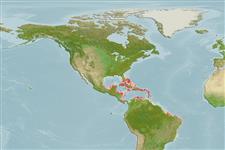>
Gobiesociformes (Clingfishes) >
Gobiesocidae (Clingfishes and singleslits) > Gobiesocinae
Etymology: Acyrtus: Greek, a = without + Greek, kyrtos, -e, -on = bent + Greek, ops = shape (Ref. 45335).
More on author: Poey.
Environment: milieu / climate zone / ระดับความลึก / distribution range
นิเวศวิทยา
เกี่ยวกับทะเล,น้ำเค็ม กลุ่มสัตว์หน้าดิน,กลุ่มสัตว์พื้นท้องน้ำ; ระดับความลึก 0 - 4 m (Ref. 26938). Tropical
Western Atlantic: Bahamas and the Greater and Lesser Antilles. Grand Cayman, Isla de Providencia, western Caribbean from Mexico to Honduras (Ref. 26938).
ขนาด / น้ำหนัก / Age
วัยเจริญพันธุ์: Lm ? range ? - ? cm
Max length : 3.5 cm TL เพศผู้/กระเทย; (Ref. 5521)
Short description
เครื่องมือที่ใช้ในการแยกชนิดสัตว์,สิ่งมีชีวิตออกจากกัน | สัณฐานวิทยา | ความยาวต่างๆ
Upper lip widest at middle; no papillae in central part of disk (Ref. 26938).
Body shape (shape guide): elongated.
Lives in close association with the sea urchin Echinometra mainly for protection. Feeds primarily on benthic crustaceans like amphipods, but harpacticoid copepods and ostracods are also eaten (Ref. 33548).
Life cycle and mating behavior
วัยเจริญพันธุ์ | การสืบพันธุ์ | การวางไข่ | เซลสืบพันธ์ของเพศเมีย(ไข่) | ความดกของไข่ | ตัวอ่อน
Böhlke, J.E. and C.C.G. Chaplin, 1993. Fishes of the Bahamas and adjacent tropical waters. 2nd edition. University of Texas Press, Austin. (Ref. 5521)
IUCN Red List Status (Ref. 130435: Version 2025-1)
Threat to humans
Harmless
Human uses
การประมง: ไม่มีผลประโยชน์
เครื่องมือ
Special reports
Download XML
แหล่งที่มาจากอินเตอร์เน็ต
Estimates based on models
Preferred temperature (อ้างอิง
123201): 26.4 - 28.2, mean 27.5 °C (based on 497 cells).
Phylogenetic diversity index (อ้างอิง
82804): PD
50 = 0.5312 [Uniqueness, from 0.5 = low to 2.0 = high].
Bayesian length-weight: a=0.00617 (0.00250 - 0.01521), b=3.15 (2.94 - 3.36), in cm total length, based on LWR estimates for this (Sub)family-body shape (Ref.
93245).
ระดับชั้นอาหาร (อ้างอิง
69278): 3.3 ±0.45 se; based on food items.
ความสามารถในการกลับคืนสู่ปกติ (อ้างอิง
120179): ความสูง, เวลาต่ำสุดที่จะทำให้ประชากรเพิ่มขึ้นเป็น 2 เท่าใช้เวลาน้อยกว่า 15 เดือน (Preliminary K or Fecundity.).
Fishing Vulnerability (Ref.
59153): Low vulnerability (10 of 100).
🛈
Nutrients (Ref.
124155): Calcium = 712 [351, 1,719] mg/100g; Iron = 1.74 [0.89, 3.50] mg/100g; Protein = 16.7 [15.5, 18.0] %; Omega3 = 0.19 [0.08, 0.43] g/100g; Selenium = 19.2 [7.3, 56.3] μg/100g; VitaminA = 94 [24, 344] μg/100g; Zinc = 2.85 [1.79, 4.42] mg/100g (wet weight);
